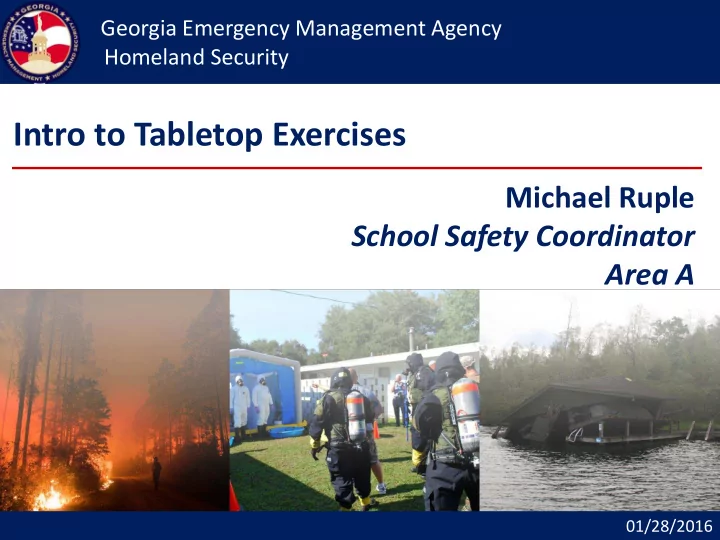

Georgia Emergency Management Agency Homeland Security Intro to Tabletop Exercises Michael Ruple School Safety Coordinator Area A 01/28/2016
Enabling Objectives • Define Exercise • Why should we conduct exercises? • Types of exercises • Tabletop Overview • Goals of a tabletop • Roles and responsibilities
Exercise • Exercise: • A focused practice activity that places participants in a simulated situation requiring them to function in the capacity that would be expected of them in a real event. • Goal is to identifying and eliminating problems before an incident occurs.
Why should we exercise? • Promote preparedness by testing policies and procedures (strengths and weaknesses) • Trains personnel in expected job functions • Practical, efficient, cost effective ways to prepare for emergencies • Training helps those affected to respond in a quicker manner (muscle memory) • “We’re preparing for the event we hope never happens.” -Denver Fire Department Captain
Types of Exercises • Orientation • Informal presentation to a group • Drill • Actual field or facility response • Tabletop • Narrative, group discussion, problem statements • Functional • Interactive, complex, conducted in real-time • Full-Scale • Field based, real-time, on-site response
Types of Exercises Tabletop Functional Full-Scale Orientation Drill Exercise Exercise Exercise Format Informal Actual field or Narrative Interactive, Realistic event discussion in facility presentation complex announcement group setting response Problem Players respond to Personnel gather Various Actual statements or messages at assigned site presentation equipment simulated (events/problems) Visual narrative methods messages provided by (enactment) simulators. Group Actions at scene discussion Realistic but no serve as input to actual equipment. No time EOC simulation pressures Conducted in real time; stressful Leaders Facilitator Manager, Facilitator Controller Controller(s) supervisor, department head, or designer Participants Single Personnel for Anyone with Players (policy, All levels of agency/ the function a policy, coordination, and personnel (policy, department, being tested planning, or operations coordination, or cross- response role personnel) operations, field) May include functional for the type of coordination, Simulators Evaluators situation operations, used Evaluators response personnel Facilities Conference Facility, field, Large EOC or other Realistic setting room or EOC conference operating center EOC or other room (multiple rooms) operating center 1 – 2 hours ½ – 2 hours 1 – 4 hours or 3 – 8 hours or longer Time 2 hours to 1 or longer more days
Pros and Cons to Tabletop Exercise
Facilitator role • Facilitators have multiple responsibilities while running a tabletop exercise: • Identify evaluators and scribes • Set the stage for the exercise (frame it up) • Involve all participants • Encourage in-depth problem solving • Control pace and flow of exercise and messages • Provide reference materials (EOPs or handouts) • Ensure layout is conducive to desired atmosphere
Tabletop Goal #1 1. Establish Base 1. Review Plans 2. Conduct Needs Assessment (How you determine what exercise should cover) 1. Identify hazards 2. Identify priority- likelihood, magnitude, consequences, etc. 3. Scope (How big and involved) 1. What area? 2. Who should be participating? (PD, SO, EMA, Hospital, Dieticians, Nurses, Communications, etc.) 4. What do we expect to gain from exercise?
Tabletop Goal #2 1. Exercise development 1. Assemble planning team 2. Needs/Scope/Objectives may be revisited depending on complexity 3. Create a narrative 4. Design the major and detailed events- what is happening to further the simulation 5. What are the expected actions? 6. Design messages to further challenge our team
Tabletop Goal #3 1. Conduct the Exercise 1. Be clear about scenario and expectations 2. Foster realism (encourage participants not to “fight the scenario”) 3. Establish timelines 4. Review emergency call off procedures 5. Capitalize on problem situations- encourage group discussion to solve issues 6. Insert messages to further challenge problem solving and discussion
Tabletop Goal #4 1. Evaluate and Critique 1. Constructive criticism 2. What improvements were noted? 3. What training was identified? 4. Staffing solutions to enhance preparations?
Tabletop Goal #5 1. Exercise follow-up 1. What timeline are improvements expected to be implemented? 2. Who and when will training be conducted? 3. Any additional information that was identified and needs to be clarified
Practical Activity
Additional Resources • FEMA Online Courses • IS-120 Intro to Exercises • IS-130 Exercise Evaluation and Improvement Planning • Schools within district that have completed • Other districts (build those relationships!) • Local EMAs • School Safety Coordinators
Guides
Guides contd
School Safety Coordinators
Questions? Michael Ruple GEMA/HS School Safety Unit Michael.Ruple@gema.ga.gov 404-275-7427
Recommend
More recommend